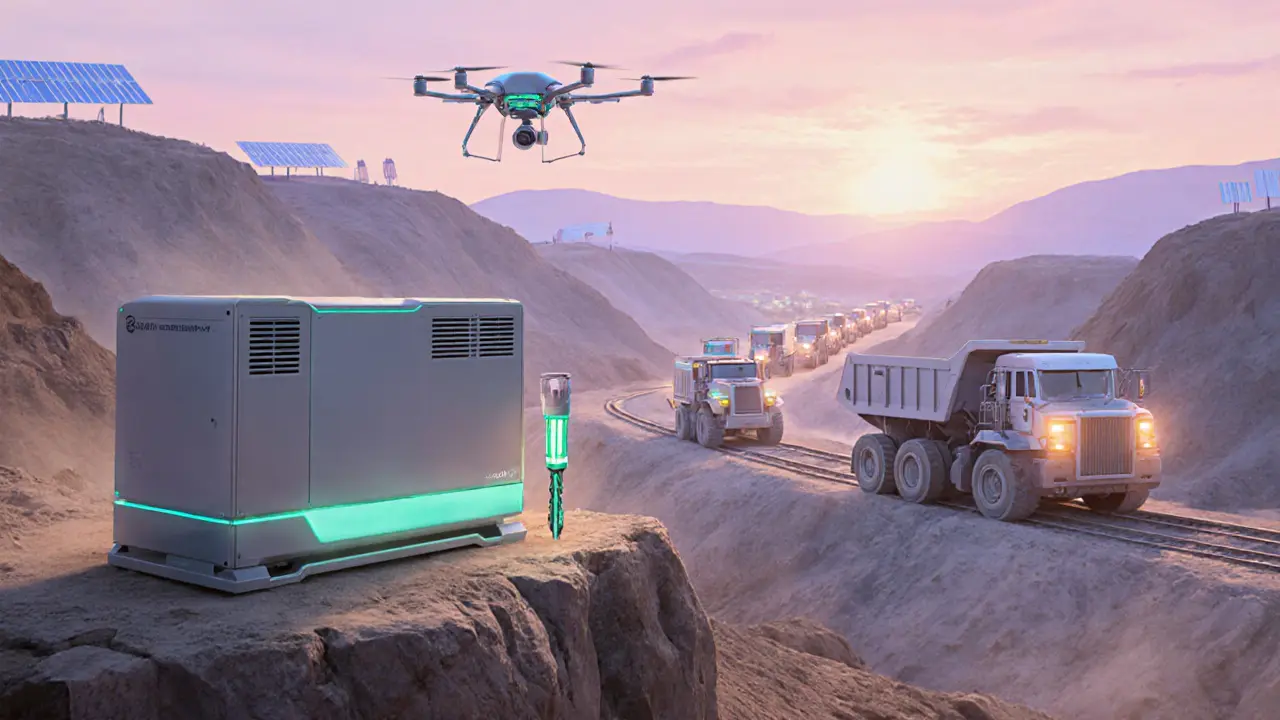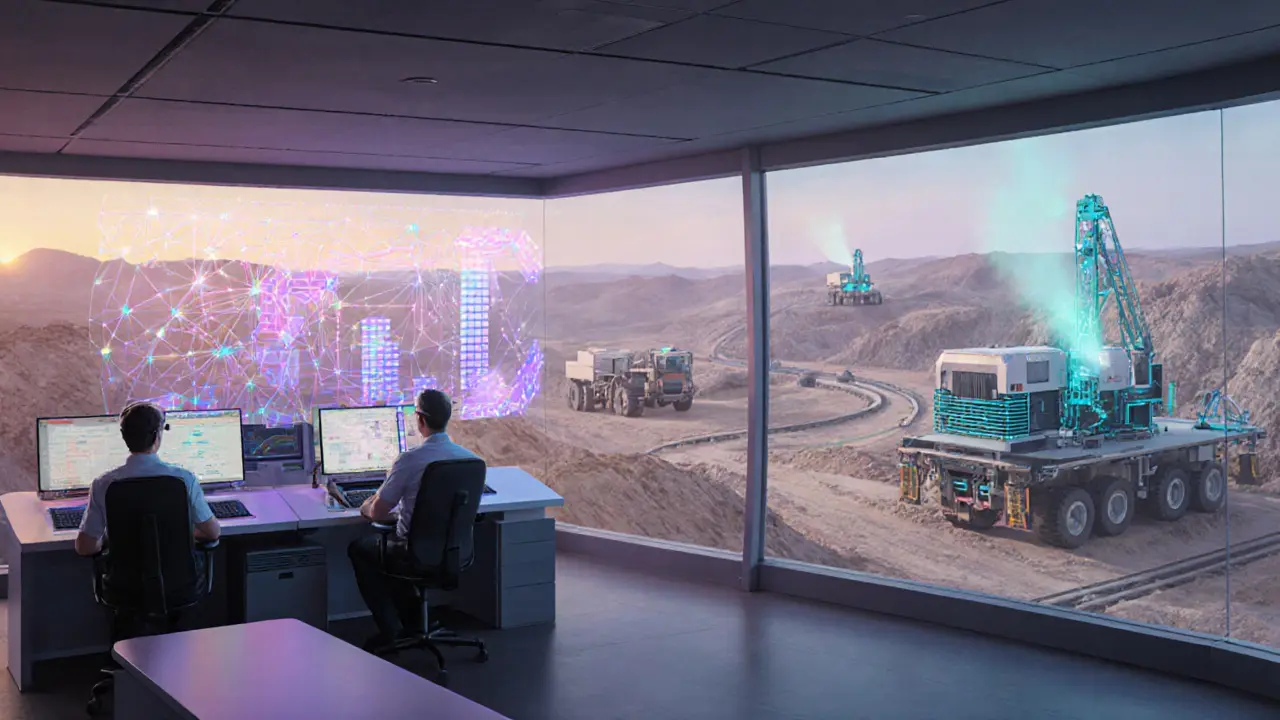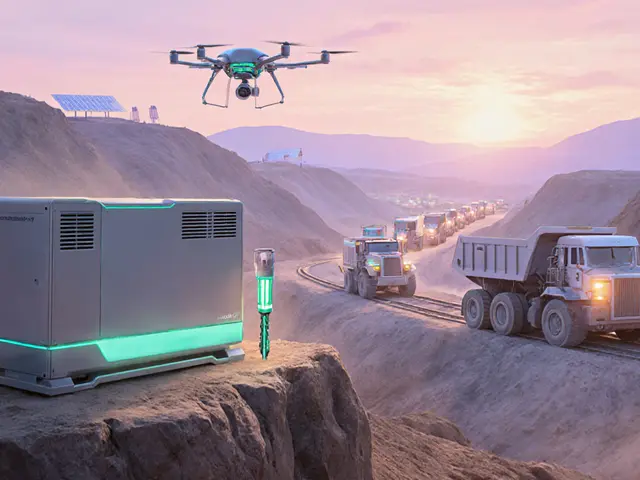Future of Mining Hardware Technology: 2025 Trends and Innovations

Mining Hardware Efficiency Calculator
Select Hardware Innovations
Choose up to three innovations you're considering for your mining operation to estimate combined efficiency gains.
Your Estimated Efficiency Gains
Select hardware innovations above and click "Calculate" to see projected improvements.
Mining is getting a tech makeover, and the hardware that powers the pits is at the heart of it. From AI‑tuned edge nodes to driverless trucks, the next wave of mining hardware promises faster, safer, and greener operations. Below you’ll find the most critical trends, the seven breakthrough innovations slated for rollout in 2025‑2026, and practical guidance on picking the right gear for your mine.
TL;DR - Quick Takeaways
- Autonomous fleets are set to double market size to $6.2billion by 2026.
- AI‑optimized edge storage nodes cut data‑processing latency by up to 40%.
- Ruggedized HDD systems improve efficiency 35% in harsh‑site conditions.
- Hybrid HDD‑SSD architectures deliver 28% faster reporting on survey data.
- Sustainability drives a shift toward electric, energy‑efficient machines and blockchain‑based data traceability.
Why Hardware Is the New Frontier
Digital spend in mining jumped 25% in 2025, signaling that executives now view hardware as a strategic asset, not just a cost center. The shift is fueled by three forces:
- AI integration enables real‑time ore‑grade assessment directly at the drill site.
- Automation removes workers from hazardous zones, boosting safety and allowing 24/7 operation.
- Sustainability mandates push manufacturers toward low‑emission, energy‑efficient designs.
When these forces converge, hardware upgrades start delivering double‑digit productivity gains while slashing carbon footprints.
Seven Game‑Changing Innovations for 2025‑2026
Below is a snapshot of the technologies that will define the next generation of mining hardware.
| Innovation | Core Benefit | Typical Efficiency Gain |
|---|---|---|
| Ruggedized HDD Mining System | Shock, temperature, dust resistance for remote drilling data logging | 35% |
| AI‑Optimized Edge Storage Node | On‑site analytics and ore‑grade assessment | 40% |
| Hybrid HDD‑SSD Storage Architecture | Tiered storage - long‑term surveys on HDD, instant reporting on SSD | 28% |
| IoT‑Embedded HDD Device | Automated data flow from sensors for environmental monitoring | 25% |
| Energy‑Efficient HDD Platform | Advanced thermal and power management for green data centers | 32% |
| Blockchain‑Integrated Data Traceability | Immutable ledger for compliance audits and mineral provenance | 30% |
| Self‑Healing Storage Platform | AI‑driven error correction and continuous archiving | 38% |
Each of these innovations targets a specific bottleneck-whether it’s data latency, equipment downtime, or regulatory compliance. Together they form a modular stack that can be customized for any mine’s size and geography.
Autonomous Mining Equipment: The Speed Bump Is Gone
Autonomous fleets are no longer a pilot project. Market analysts forecast the sector will double to $6.2billion by 2026, led by self‑driving haul trucks, robotic drill rigs, and drone‑based inspection units. The hardware upgrades that enable autonomy include:
- High‑precision LiDAR arrays paired with ruggedized processing units.
- Redundant communication stacks using 5G and private LTE for millisecond‑level control.
- Integrated safety cages that monitor proximity and automatically trigger emergency stops.
Real‑world deployments-like the driverless fleet at a copper mine in Chile-have cut incident rates by 70% and lifted overall equipment effectiveness (OEE) from 55% to 80%.

Sustainable & Energy‑Efficient Designs
Environmental regulations are tightening worldwide, and mining firms are responding with electrified trucks, hybrid loaders, and low‑heat‑output cooling systems. Energy‑efficient HDD platforms, mentioned earlier, cut power draw by roughly one‑third while maintaining the same throughput.
Coupling these machines with renewable micro‑grids-solar panels on site and wind turbines where applicable-creates an almost self‑sufficient power ecosystem. The result: up to 25% lower CO₂ emissions per tonne of ore processed.
Data Management, AI, and Blockchain: The Digital Backbone
Data silos are a thing of the past. Modern mines run a digital twin of the entire operation, fed by edge nodes, IoT sensors, and satellite imagery. AI models ingest this stream to predict equipment failure, optimise blasting patterns, and even forecast commodity prices.
Blockchain modules attached to storage platforms guarantee that every sample, assay, and transport record is immutable, simplifying compliance with the Extractive Industries Transparency Initiative (EITI) and local mine‑closure statutes.
Workforce Transition: From Hard Hats to Hard Drives
The hardware revolution means the skillset required on site is changing fast. Companies now need:
- Data engineers who can tune AI pipelines on edge nodes.
- Automation specialists who program autonomous vehicles and robotic drills.
- Cyber‑security analysts to protect the ever‑growing attack surface.
Training programs-often in partnership with technical colleges-are already delivering certifications in “Mining Automation & AI”. Graduates are landing roles as remote operation supervisors, a job that can be performed from a control room in Perth while the machines work miles away.
Choosing the Right Hardware Stack: A Quick Decision Guide
Not every mine needs the full suite of 2025 innovations. Use the matrix below to match your project’s priorities against the hardware categories.
| Priority | Best Fit | Key Feature | Typical ROI |
|---|---|---|---|
| Maximum safety in high‑risk zones | Autonomous haul trucks & robotic drill rigs | Real‑time collision avoidance | 2‑3years |
| Fast data‑driven decision making | AI‑optimized edge storage nodes | On‑site ore‑grade analytics | 1‑2years |
| Low‑energy footprint | Energy‑efficient HDD platforms + hybrid HDD‑SSD storage | 32% power reduction | 1‑1.5years |
| Regulatory traceability | Blockchain‑integrated data modules | Immutable audit trail | 0.8‑1year |
| Remote site resilience | Ruggedized HDD mining systems | 35% performance in extreme conditions | 1‑2years |
Run a simple pilot-swap one legacy drill rig for a robotic version and monitor OEE, safety incidents, and energy use for 90 days. The data will tell you if a broader rollout makes sense.
What’s Next? 2026 and Beyond
Looking ahead, we expect three major trends:
- Full‑site digital twins that simulate every piece of equipment in real time.
- Widespread adoption of self‑healing storage platforms that automatically fix corrupted blocks without downtime.
- Integration of metal additive manufacturing on‑site, enabling on‑demand spare‑part prints for autonomous fleets.
Those advancements will tighten the feedback loop between the ground and the control room, making the mine not just automated, but truly intelligent.

Frequently Asked Questions
How soon can a mine deploy autonomous trucks?
Most manufacturers offer retro‑fit kits that can be installed on existing haul trucks within 6‑12 months. Full fleet conversion typically takes 18‑24 months, depending on site‑specific network infrastructure and regulatory approval.
Do AI‑optimized edge nodes replace cloud processing?
They don’t replace the cloud; they complement it. Edge nodes handle latency‑critical tasks-like real‑time ore grading-while bulk analytics and model training remain in the cloud. This hybrid approach reduces bandwidth costs and improves reliability.
What are the main security concerns with connected mining hardware?
Attack vectors include spoofed sensor data, ransomware targeting control‑room software, and lateral movement through poorly segmented networks. Mitigation requires network segmentation, regular firmware patches, and AI‑driven anomaly detection.
How does blockchain improve compliance?
Every assay result, transport record, and equipment maintenance log can be written to an immutable ledger. Auditors can verify data integrity without needing physical paperwork, cutting compliance costs by up to 40%.
Is the investment in self‑healing storage worth it for smaller operations?
For mines processing under 500,000 tonnes per year, the ROI period stretches to 3‑4 years. However, the reduced downtime and data‑loss risk often justify the spend, especially when regulatory penalties are high.







When you parse the throughput matrices of the AI‑optimized edge node, the incremental latency reduction feels almost theatrical, yet the underlying cost‑benefit curve still shadows the hype.
Contemplating the dialectic between autonomous haulage and the mineral substrate reveals a deeper ontological shift, where silicon consciousness supplants human intuition, and the mining ecosystem redefines its own raison d’être.
Digging into the ruggedized HDD specs, you’ll notice the thermal envelope is engineered to survive temperature swings that would cripple conventional drives, which translates into steadier data pipelines and fewer unscheduled downtimes.
Looks like another buzz‑word parade, but the reality check is that many sites still run legacy rigs that can’t even talk to a blockchain module 🤷♂️💾.
While the ruggedized designs indeed promise resilience, the marginal gain of thirty‑five percent must be weighed against the capital outlay, and in many cases the payback horizon extends beyond the typical mine lifespan.
The moment you overlay AI analytics on edge storage, the data deluge morphs into actionable insight, slashing manual triage and forcing the old guard to confront obsolescence.
Embracing the hybrid HDD‑SSD stack can turbocharge reporting cycles, and teams that pilot this combo often see a cascade of efficiency improvements that ripple through downstream processes.
Deploying a self‑healing storage platform introduces an autonomous error‑correction loop, which not only safeguards integrity but also reduces the maintenance crew’s workload, aligning perfectly with lean operational goals.
The proactive error‑handling indeed cuts downtime, and when you factor in the reduced need for manual diagnostics, the overall equipment effectiveness climbs noticeably.
Reading through the selection of 2025 innovations feels like opening a toolbox that’s been meticulously curated by a consortium of engineers, investors, and futurists, each with a vested interest in reshaping the mining value chain; the first entry, the ruggedized HDD mining system, is not merely a hardened drive but a purpose‑built data conduit that thrives in dust‑laden, high‑vibration environments, thereby ensuring continuous logging of drill parameters without the usual hiccups that plague conventional hardware; moving on, the AI‑optimized edge storage node serves as a miniature brain at the pit’s edge, crunching ore‑grade data in real time and feeding the downstream decision matrix with confidence intervals that were previously only possible in cloud‑based post‑processing; the hybrid HDD‑SSD architecture cleverly balances the need for massive archival capacity with the speed demands of instantaneous reporting, a duality that mirrors the classic trade‑off between breadth and depth in data strategy; the IoT‑embedded HDD device extends this paradigm by automating sensor data ingestion, effectively turning every drill bit into a smart endpoint that whispers its status to the central command center; energy‑efficient HDD platforms, with their refined thermal management algorithms, slash power draw by a third, contributing directly to the sustainability targets that regulators and shareholders alike are demanding; blockchain‑integrated data traceability, while sounding like a buzz phrase, actually furnishes an immutable ledger that can streamline compliance audits and engender trust across the supply chain; the self‑healing storage platform, perhaps the most avant‑garde offering, leverages AI to detect and remediate corruption before it propagates, thereby preserving data fidelity in the face of hardware wear; each of these technologies, when examined through the lens of total cost of ownership, reveals a nuanced picture where upfront capital expenditure is offset by gains in operational uptime, safety enhancements, and regulatory goodwill; the convergence of autonomous fleets with these hardware upgrades creates a feedback loop where data informs motion, and motion generates fresh data, a virtuous cycle that accelerates ROI; practitioners who adopt a phased rollout-starting with pilot units on select rigs-can empirically validate the projected efficiency metrics before committing to enterprise‑wide deployment; furthermore, the modular nature of these innovations means that mines can tailor their stack to specific geological challenges, whether that be deep‑hard rock, arid surface pits, or sub‑sea ore extraction; the market analysts’ forecast of a $6.2 billion autonomous fleet sector by 2026 underscores the commercial viability of such integrations; finally, the broader industry narrative points toward a future where the line between physical extraction and digital orchestration blurs, heralding an era of truly intelligent mining operations.
It is a lamentable misconception that the mere infusion of cutting‑edge hardware will magically resolve entrenched inefficiencies, for true progress demands disciplined process reengineering alongside technological adoption.
Yo, tossing an energy‑efficient HDD into the mix is a low‑effort win that can shave a chunk off the power bill while the trucks keep on rolling.
The gadgets look shiny but they won’t fix a mine that’s already broken at the core.
Integrating blockchain into the data pipeline creates a tamper‑proof audit trail, yet the overhead of consensus algorithms can nibble at throughput, so you’ve got to balance immutability against latency 📈🔗.
The symphony of autonomous loaders, AI edge analytics, and self‑healing storage orchestrates a harmonious cadence that elevates overall equipment effectiveness, and seasoned engineers who mentor junior staff through hands‑on labs often witness the most rapid assimilation of these breakthroughs.
The meticulous calibration of thermal controls on energy‑efficient platforms reduces heat dissipation, thereby extending component lifespan, which in turn lowers replacement cycles and aligns with sustainability mandates 🙂.
Adopt the pilot, watch the numbers climb.